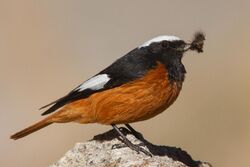Biology:Güldenstädt's redstart
| Güldenstädt's redstart | |
|---|---|

| |
| Güldenstädt's redstart (male) from Ladakh, India | |
| Scientific classification | |
| Domain: | Eukaryota |
| Kingdom: | Animalia |
| Phylum: | Chordata |
| Class: | Aves |
| Order: | Passeriformes |
| Family: | Muscicapidae |
| Genus: | Phoenicurus |
| Species: | P. erythrogastrus
|
| Binomial name | |
| Phoenicurus erythrogastrus (Güldenstädt, 1775)
| |
Güldenstädt's redstart (Phoenicurus erythrogastrus) also sometimes called the white-winged redstart, is a species of bird in the genus Phoenicurus, family Muscicapidae. It is found in the high mountains of the southwestern and central Palearctic in the Caucasus, Karakoram, Pamir, Himalaya , Tian Shan, and Altai, in the countries of Afghanistan, Armenia, Azerbaijan, Bhutan, China , Georgia, India , Iran, Kazakhstan, Mongolia, Nepal, Pakistan , Russia , Tajikistan, Turkmenistan, and Uzbekistan.[2]
It is one of the largest redstarts, 18 cm long and 21–29 g weight. The adult male is black above except for a white crown, a white patch on the wing, and an orange-red tail; below, the throat and upper breast are black, and the rest of the underparts a rich orange-red. The female and immature male are brown above and orange-buff below, with an orange-red tail.[2]
It breeds at high altitudes from 3,600–5,200 m in alpine meadows and rock-fields, moving slightly lower to 1,500–4,800 m in winter where it occurs mainly in subalpine Hippophae scrub; some populations, notably the northernmost in the mountains around Lake Baikal, migrate further, reaching northeastern China. It feeds on fruit and a wide variety of invertebrates.[2]
Taxonomy and relationships
There are two subspecies:[2]
- Phoenicurus erythrogastrus erythrogastrus, Caucasus
- Phoenicurus erythrogastrus grandis, Central Asian mountains
In plumage and size the male closely resembles the white-capped redstart Chaimarrornis leucocephalus, sharing the black upperparts and white crown, but lacking the white wing patch.[2] Although the white-capped redstart is currently placed in a separate genus Chaimarrornis, this genus is not genetically distinct and is likely to be merged into Phoenicurus in the future.[3] Male Güldenstädt's redstarts also show some plumage similarities to the much smaller Moussier's redstart P. moussieri, including the white wing patch, while the females more resemble an outsized common redstart.[2]
The scientific name was usually cited in older texts as Phoenicurus erythrogaster, though this is an error in Latin grammar.[2]
References
- ↑ BirdLife International (2017). "Phoenicurus erythrogastrus". IUCN Red List of Threatened Species 2017: e.T22710072A113283079. doi:10.2305/IUCN.UK.2017-1.RLTS.T22710072A113283079.en. https://www.iucnredlist.org/species/22710072/113283079. Retrieved 12 November 2021.
- ↑ 2.0 2.1 2.2 2.3 2.4 2.5 2.6 Hoyo, J. del, ed (2005). Handbook of the Birds of the World, vol. 10. Barcelona: Lynx Edicions. pp. 773. ISBN 84-87334-72-5. https://archive.org/details/handbookofbirdso0001unse/page/773.
- ↑ Sangster, G., Alström, P., Forsmark, E., & Olsson, U. (2010). Multi-locus phylogenetic analysis of Old World chats and flycatchers reveals extensive paraphyly at family, subfamily and genus level (Aves: Muscicapidae). Molecular Phylogenetics and Evolution 57: 380–392 Full text
Wikidata ☰ Q796484 entry
 |



